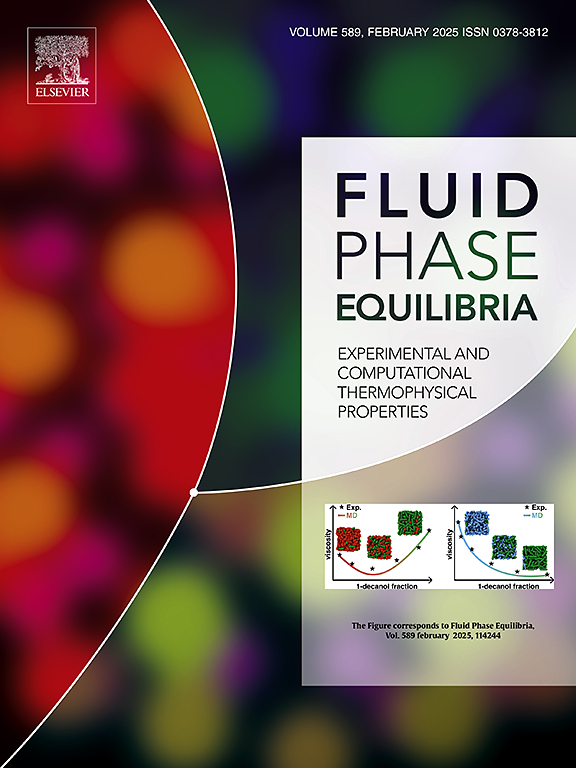Multi-objective optimization of PC-SAFT parameters for ionic liquids from density and viscosity data using entropy scaling
IF 2.8
3区 工程技术
Q3 CHEMISTRY, PHYSICAL
引用次数: 0
Abstract
Equations of state using the Statistical Associating Fluid Theory (SAFT EoS) have found tremendous success in the thermodynamic modeling of ionic liquids (ILs) and mixtures. Traditionally, SAFT EoS parameters are fit to pure component pressure-volume-temperature (PVT) (density) data and vapor pressure data. We have recently combined the PC-SAFT EoS with entropy scaling theory to correlate and predict the viscosity of ILs and IL mixtures. We found that the PC-SAFT EoS parameters for ionic liquids regressed to PVT data can sometimes lead to relatively large deviations in the viscosity correlations, especially at high pressure. Here, we investigate the effect of including viscosity data along with PVT data for the PC-SAFT parameter regression of two series of 1-n-alkyl-3-methyl imidazolium ionic liquids ([CnMIm][Tf2N] and [CnMIm][BF4]). From analyzing the Pareto fronts, the inclusion of viscosity data to PVT data for PC-SAFT parameters resulted in only a small loss in accuracy for the density, but with much improved viscosity correlations through entropy scaling. We found that the parameter sets obtained from density and viscosity data regression are less prone to numerical pitfalls, i.e. fictitious SAFT critical points, than the parameter sets obtained from PVT data alone. In addition, the predicted (kij=0) phase equilibrium (VLE) of ionic liquids and mixtures with CO2, CH4, and water were equal to, if not better than the predictions using PVT data alone. Overall, the use of pure PVT and viscosity data in the parameterization of PC-SAFT yields a more widely applicable prediction method for both thermodynamic and transport properties.

求助全文
约1分钟内获得全文
求助全文
来源期刊

Fluid Phase Equilibria
工程技术-工程:化工
CiteScore
5.30
自引率
15.40%
发文量
223
审稿时长
53 days
期刊介绍:
Fluid Phase Equilibria publishes high-quality papers dealing with experimental, theoretical, and applied research related to equilibrium and transport properties of fluids, solids, and interfaces. Subjects of interest include physical/phase and chemical equilibria; equilibrium and nonequilibrium thermophysical properties; fundamental thermodynamic relations; and stability. The systems central to the journal include pure substances and mixtures of organic and inorganic materials, including polymers, biochemicals, and surfactants with sufficient characterization of composition and purity for the results to be reproduced. Alloys are of interest only when thermodynamic studies are included, purely material studies will not be considered. In all cases, authors are expected to provide physical or chemical interpretations of the results.
Experimental research can include measurements under all conditions of temperature, pressure, and composition, including critical and supercritical. Measurements are to be associated with systems and conditions of fundamental or applied interest, and may not be only a collection of routine data, such as physical property or solubility measurements at limited pressures and temperatures close to ambient, or surfactant studies focussed strictly on micellisation or micelle structure. Papers reporting common data must be accompanied by new physical insights and/or contemporary or new theory or techniques.
 求助内容:
求助内容: 应助结果提醒方式:
应助结果提醒方式:


